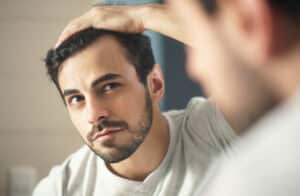Laser light hair growth uses Low-Level Laser Therapy (LLLT) to stimulate hair follicles and promote hair growth. This article explains how it works, its effectiveness, and what you can expect.
Key Takeaways
- Low-Level Laser Therapy (LLLT) utilizes red light therapy to stimulate hair follicles, promoting hair regrowth safely and effectively for both men and women.
- LLLT enhances hair growth through three primary mechanisms: stimulating hair follicles, increasing ATP production, and boosting blood flow to the scalp.
- A variety of FDA-approved laser devices, such as helmets, combs, and caps, are available, offering convenient and non-invasive options for users seeking to address thinning hair and alopecia.
Understanding Laser Light Hair Growth
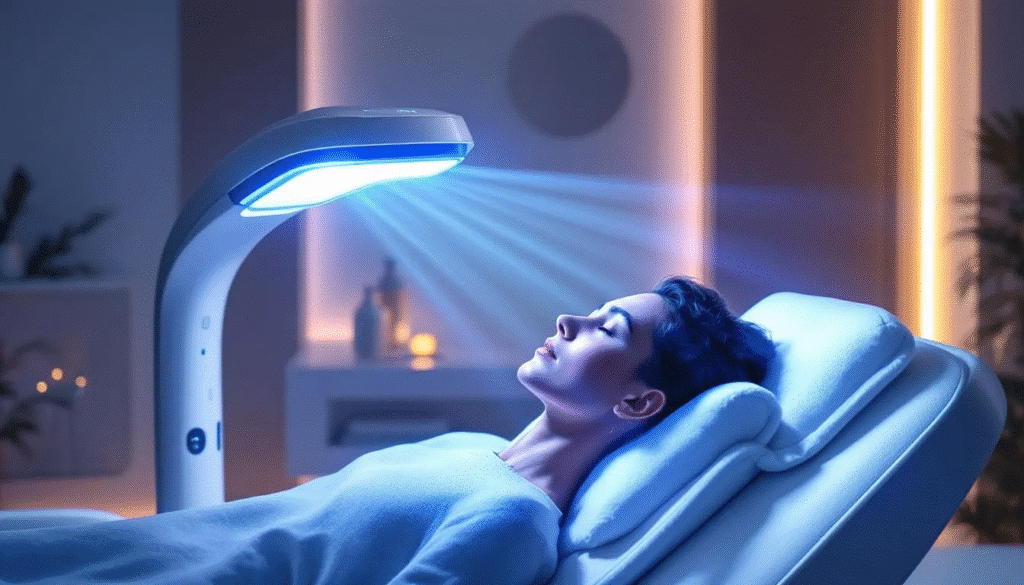
Low-Level Laser Therapy (LLLT) is emerging as a groundbreaking treatment option for hair regrowth. Utilizing red light therapy, LLLT stimulates hair follicles by delivering photons to scalp cells, revitalizing them and promoting their activity. This process triggers biochemical changes within the cells, which in turn stimulate various cellular processes essential for hair growth.
The beauty of LLLT lies in its ability to operate at a cellular level, influencing the growth cycle of hair follicles. LLLT helps transition follicles from the resting phase (telogen) to the active growth phase (anagen), promoting hair regrowth by stimulating these cellular functions. This mechanism is fundamentally different from other hair loss treatments that often involve invasive procedures or chemical applications.
Moreover, LLLT is considered both safe and effective for hair growth in men and women, making it a versatile treatment option. LLLT enhances the supply of essential nutrients to the scalp by increasing blood flow, which further stimulates new hair growth. This holistic approach not only addresses hair loss but also supports long-term hair health.
The Mechanisms of LLLT in Hair Regrowth
The primary mechanisms of LLLT that promote hair regrowth include stimulating hair follicles, increasing ATP production, and enhancing blood flow. Each of these processes plays a crucial role in revitalizing hair follicles and supporting healthy hair growth.
Stimulating Hair Follicles
One of the key mechanisms by which LLLT promotes hair growth is through the stimulation of hair follicles. This process involves:
- Activation of hair follicles by LLLT
- Transition of follicles from the telogen (resting) phase to the anagen (growth) phase
- The anagen stage, which typically lasts between two to six years, is when hair actively grows
- Triggering this transition helps initiate and maintain the growth phase, leading to increased hair density and thickness.
This process is particularly beneficial for individuals experiencing androgenetic alopecia, commonly known as male and female pattern hair loss, including male androgenetic alopecia. Stimulating the hair follicles with LLLT counteracts the effects of this condition, promoting new hair growth and improving overall hair health. This makes LLLT a promising option for those looking to regrow hair and combat thinning hair effectively.
Increasing ATP Production
Another significant way LLLT promotes hair growth is by enhancing ATP production within cells. ATP, or adenosine triphosphate, is the energy currency of cells, crucial for powering cellular functions and promoting hair follicle activity. LLLT acts on mitochondria, the energy powerhouses of cells, boosting ATP synthesis and thereby supporting hair growth through light energy.
Increasing ATP levels enhances cellular metabolism, which is essential for the active growth phase of hair follicles. This heightened metabolic activity provides the necessary energy for hair follicles to function optimally, promoting hair regrowth and improving hair density and thickness, resulting in hair tensile strength and increased hair tensile strength. The result is healthier, more robust hair.
Enhancing Blood Flow
LLLT also promotes hair growth by enhancing blood flow to the scalp. Improved blood circulation ensures that hair follicles receive a steady supply of essential nutrients and oxygen, which are vital for healthy hair growth. The application of LLLT can lead to increased blood flow by promoting the release of nitric oxide, a compound known for its vasodilatory effects.
Enhanced blood circulation not only supports nutrient delivery but also helps to remove waste products from the scalp, creating a healthier environment for hair follicles. This dual action of nutrient supply and waste removal ensures that hair follicles can function at their best, leading to significant improvements in hair growth and overall hair health.
Types of Laser Devices for Hair Growth
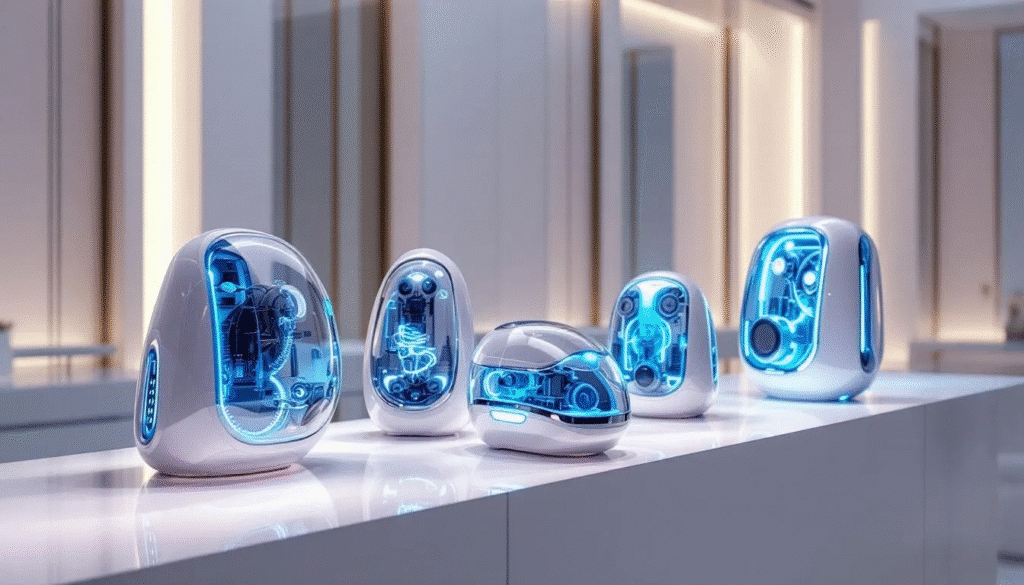
When it comes to LLLT for hair growth, there are various types of laser devices available, each designed to cater to different needs and preferences. Common laser devices for hair regrowth include:
- Bands
- Combs
- Helmets
- Caps Each of these devices has its unique features and benefits. These devices utilize low-level laser therapy to stimulate hair follicles and promote hair growth.
Laser helmets, for instance, are favored for their convenience, allowing users to multitask while undergoing treatment. On the other hand, handheld devices like laser technology combs and brushes offer targeted treatment, making them suitable for individuals who prefer a more hands-on approach.
Understanding the different types of laser devices can help users choose the one that best fits their lifestyle and hair regrowth goals.
Laser Caps
Laser caps are designed to cover the entire scalp, providing uniform treatment for hair regrowth. One notable example is Kiierr’s 272 Premier laser cap, which offers full scalp coverage with 272 laser diodes, ensuring effective hair regrowth. These caps combine comfort with technology, allowing users to engage in daily activities while treating their hair. Key features include:
- Full scalp coverage
- 272 laser diodes for effective treatment
- Combination of comfort and technology
- Allows users to perform daily activities during treatment
The advanced design and technology of laser caps make them a popular choice for those seeking a convenient and effective solution for hair loss. Low-level laser therapy (LLLT) performed with these caps is non-invasive and can be done at home or in a clinic, making it a versatile option for ongoing hair regrowth treatments.
Laser Combs and Brushes
Handheld laser comb and brushes are effective LLLT devices designed for convenient home use, targeting hair loss. These devices are easy to use, allowing users to incorporate them into their daily routine without requiring extensive effort. User reviews indicate high satisfaction levels with handheld laser comb and brushes, citing visible results in hair thickening and ease of use.
These handheld devices offer a targeted approach to hair regrowth, making them suitable for individuals who prefer to focus on specific areas of hair thinning. Their portability and ease of use make them a practical choice for individuals looking to treat hair loss on the go.
Laser Bands
Laser bands offer a convenient option for individuals seeking to address hair thinning, making it easier to incorporate into daily routines. These bands effectively stimulate hair follicles, transitioning them into the growth phase and promoting hair regrowth. Additionally, laser bands enhance blood circulation to the scalp, further supporting the nourishment of hair follicles and hair health.
Combining their convenience with proven efficacy, laser bands represent a practical and effective solution for individuals experiencing hair thinning. Their ease of use and ability to deliver consistent results make them a popular choice among users seeking to improve their hair health.
Clinical Evidence Supporting LLLT

The efficacy of LLLT for hair growth is supported by a substantial body of clinical evidence. Bands, combs, helmets, and other laser-containing products are marketed for hair regrowth, and various studies have demonstrated their effectiveness. LLLT has been shown to improve various types of non-scarring alopecias. This includes conditions such as androgenetic alopecia (AGA), alopecia areata (AA), and chemotherapy-induced alopecia.
A total of 21 studies were reviewed in a 2015 analysis of LLLT for hair growth, with five of those being randomized controlled trials. These studies utilized keywords like alopecia, hair loss, LLLT, and photobiomodulation in their searches, highlighting the comprehensive nature of the research conducted.
Further studies are necessary to optimize treatment parameters. It’s also important to evaluate the long-term efficacy and safety of LLLT.
Randomized Controlled Trials
Clinical trials have demonstrated that low-level laser therapy (LLLT) stimulates hair growth in both men and women. For instance, a 2018 scientific review analyzed 11 clinical trials and found that LLLT significantly increased hair density. In a trial with the HairMax Lasercomb, patients experienced noticeable improvements in hair growth, with 83% reporting satisfaction with the results.
These randomized controlled trials provide robust evidence of LLLT’s effectiveness, showing that it can significantly boost hair density and terminal hair density, particularly when started in the early stages of hair loss. The effectiveness of LLLT can vary, with some users experiencing significant hair regrowth while others see little to no improvement.
Safety and Side Effects
LLLT is generally recognized as a low-risk lllt treatment, making it a safer alternative compared to more invasive procedures like hair transplants. Most participants in studies observing LLLT reported very few side effects, primarily temporary hair shedding at the onset of treatment.
However, LLLT is contraindicated for individuals with active scalp lesions, as it may exacerbate existing conditions. Devices cleared by the FDA have been assessed for safety and efficacy, providing assurance to users.
Comparing LLLT with Other Hair Loss Treatments
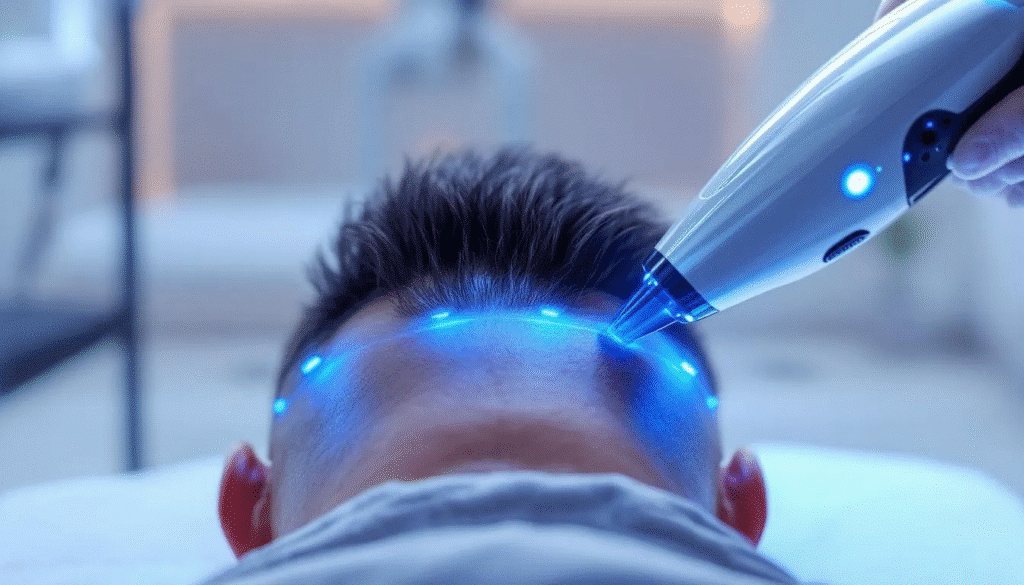
When it comes to hair loss treatments, LLLT stands out as a non-invasive option that can be effectively combined with treatment options and other treatments for enhanced results.
This section compares LLLT with other common hair loss treatments, highlighting their respective benefits and drawbacks.
Topical Minoxidil
Studies indicate that combining low-level light therapy (LLLT) with topical minoxidil may result in greater hair density compared to using minoxidil alone. Topical minoxidil is a common treatment that promotes hair regrowth by increasing blood flow to the hair follicles and stimulating them.
Combining LLLT with topical minoxidil can enhance overall results for individuals experiencing hair loss through a synergistic effect. This combination leverages the strengths of both treatments, offering a more comprehensive approach to promoting hair growth.
Hair Transplant Surgery
Compared to hair transplant surgery, LLLT is less invasive, requires no recovery time, and can be used at home. Hair transplants involve relocating hair follicles from a donor area to balding regions, offering a permanent solution but with recovery time and potential scarring.
Hair transplant surgery provides permanent solutions for severe hair loss by relocating hair follicles from denser areas on the scalp. However, the success rate of hair transplants depends heavily on the surgeon’s skill and the health of the transplanted follicles.
When deciding between LLLT and hair transplant surgery, consider factors such as the severity of hair loss, desired permanence of results, and tolerance for recovery time.
Natural Remedies
Natural remedies like saw palmetto have shown potential benefits in improving hair growth, particularly in cases of androgenetic alopecia and telogen effluvium. Clinical studies indicate that supplements containing saw palmetto can enhance overall hair quality and density in a significant percentage of users. These remedies are often preferred due to their lower side effect profile compared to conventional hair loss treatments. Additionally, they may help to treat androgenic alopecia.
However, the effectiveness of natural remedies in treating hair loss requires further research to establish their clinical efficacy and safety over prolonged use. While they may serve as complementary options, they may not offer the same level of scientific backing as FDA-approved treatments like LLLT.
For those seeking an evidence-based approach to hair regrowth, evidence suggests that LLLT is a clinically proven compelling option.
Choosing the Right LLLT Device
Selecting the right LLLT device is crucial for effective treatment of hair thinning and alopecia. Choosing FDA-approved devices ensures safety and efficacy. These devices have undergone rigorous testing, providing confidence to users in their effectiveness.
Consider key features such as power output, ease of use, and treatment duration when choosing a home use lllt devices. Analyzing customer feedback and testimonials can also help in making an informed decision about which lllt device will best suit individual needs.
FDA-Approved Devices
FDA approval ensures that laser devices have undergone rigorous testing for safety and efficacy, providing confidence to users. Research shows that FDA-approved LLLT devices are effective in promoting hair regrowth for individuals with thinning hair and alopecia.
Non-FDA approved devices may not have the same level of safety and efficacy validation, posing risks to users. Choosing a food and drug administration-approved device minimizes the risk associated with untested products, ensuring better outcomes in hair restoration treatments.
Key Features to Consider
Adequate total power output significantly impacts the effectiveness of an LLLT device in promoting hair growth. Power output is a critical specification to assess when comparing LLLT devices since higher power can lead to more effective treatments.
User-friendliness is another important factor; devices should be comfortable to wear and easy to operate for regular use. User-friendly designs enhance the overall experience with LLLT devices, making treatment sessions more convenient.
User Reviews and Testimonials
Customer feedback often highlights the convenience and effectiveness of LLLT devices for hair regrowth. The iRESTORE Hair Growth System has received numerous positive reviews highlighting its effectiveness for users experiencing hair thinning.
Many customers report noticeable improvements in hair thickness and growth after consistent use of LLLT devices. Testimonials often highlight the importance of consistency in using LLLT devices to achieve desired hair restoration results.
Low-Level Laser Therapy (LLLT) with the Xtrallux® Extreme RX
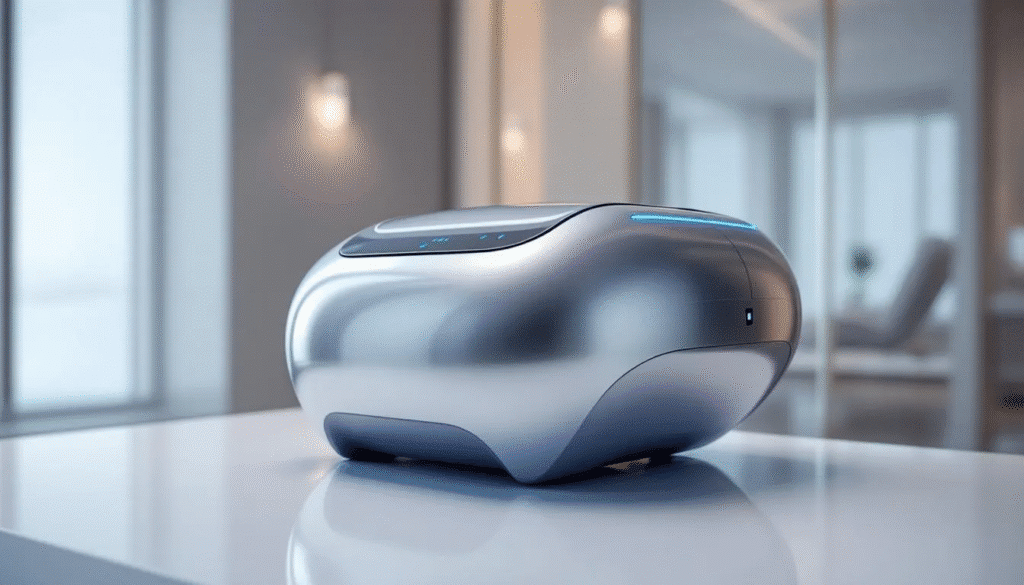
If you’re looking for a non-invasive, drug-free way to boost hair regrowth, Low-Level Laser Therapy (LLLT) could be your solution. At Best Hair Transplant, we proudly offer the Xtrallux® Extreme RX, a premium LLLT device designed to stimulate dormant follicles, strengthen thinning hair, and support long-term hair health—all from the comfort of your home.
The Xtrallux® Extreme RX stands out with its advanced technology and user-friendly design, making it an excellent choice for those seeking effective hair loss treatments.
Why Choose the Xtrallux® Extreme RX?
The Xtrallux® Extreme RX sets a new standard in LLLT devices with its 352 medical-grade laser diodes, ensuring deeper penetration and maximum scalp coverage for more effective results. Unlike many other caps on the market that use light emitting diodes or a lower count of laser diodes, the Xtrallux® Extreme RX provides superior performance in promoting hair growth with a visible red light laser, as supported by research published in lasers med sci.
In addition to its clinically backed technology, the cap is lightweight, cordless, and rechargeable, making it perfect for multitasking while undergoing treatment. This combination of advanced technology and user-friendly design makes the Xtrallux® Extreme RX a top choice for those serious about hair regrowth.
Limited Offer: $1,000 Study Subsidy
The Xtrallux® Extreme RX currently retails for $3,500 + tax, but we’re offering a $1,000 subsidy to select patients who agree to participate in our 12-month before-and-after case study. This is your chance to experience professional-grade results at a reduced cost while helping others see what’s possible with LLLT.
All that’s required: take monthly scalp photos and follow the usage protocol. Our team will guide you through the process, ensuring you get the most out of your treatment while contributing to valuable research.
Is LLLT Right for You?
LLLT works best in the following situations:
- In the early to moderate stages of hair thinning
- As a complement to a recent hair transplant
- For those seeking a natural way to preserve or enhance existing hair
If you’re looking for a non-invasive, scientifically backed solution to support your hair regrowth journey, LLLT could be the right choice for you. It offers a promising alternative to more invasive procedures, with the added convenience of home use.
Summary
Low-Level Laser Therapy (LLLT) has emerged as a revolutionary solution for hair regrowth, offering a non-invasive, scientifically backed approach to treating hair thinning and alopecia. By understanding the mechanisms of LLLT, exploring the different types of devices, and comparing it with other hair loss treatments, we can appreciate its potential to transform hair health.
Whether you choose an FDA-approved laser cap, comb, or band, the key to success lies in consistency and selecting the right device for your needs. The Xtrallux® Extreme RX stands out as a top choice, combining advanced technology with user-friendly design. Embrace the possibilities of LLLT and take the first step towards healthier, thicker hair.
Frequently Asked Questions
How does LLLT promote hair growth?
LLLT effectively promotes hair growth by stimulating hair follicles, increasing ATP production, and enhancing blood flow to the scalp. This combination fosters hair regrowth and improves overall hair health.
Are LLLT devices safe to use?
LLLT devices are safe to use, especially those that are FDA-approved, as they have been thoroughly tested for safety and efficacy. You can trust these devices for hair regrowth.
Can LLLT be combined with other hair loss treatments?
Yes, LLLT can be effectively combined with other hair loss treatments, such as topical minoxidil, to enhance overall hair growth outcomes. This synergistic approach may improve results significantly.
How long does it take to see results with LLLT?
You can expect to see noticeable improvements in hair thickness and growth after several months of consistent use with Low-Level Laser Therapy (LLLT). Patience and regular application are key to achieving desired results.
Is LLLT suitable for all types of hair loss?
LLLT is not suitable for all types of hair loss; it is particularly effective for androgenetic alopecia and chemotherapy-induced alopecia, especially in the early to moderate stages of thinning.

